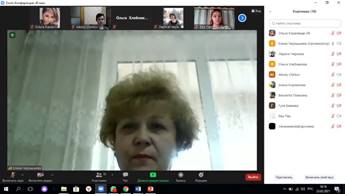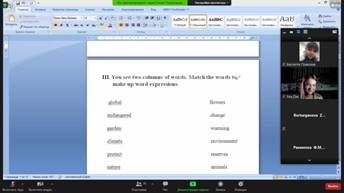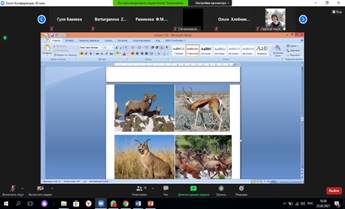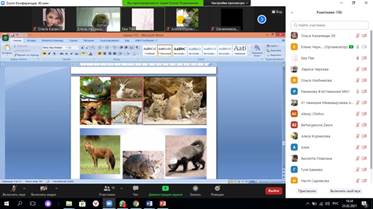
Lesson plan
|
Unit 6. The Natural World |
School: gymnasium 41 |
|||||||
|
Date: 23.02.2021 |
Teacher name: Chernysheva Y. A. |
|||||||
|
Grade: 8 L |
Number present: |
absent: |
||||||
|
Theme of the lesson |
The natural World |
|||||||
|
Learning objectives(s) that this lesson is contributing to |
8.5.8.1 spell most high-frequency vocabulary accurately for a range of familiar general and curricular topics 8.2.2.1 understand with little or no support most specific information in extended talk on a wide range of general and curricular topics 8.2.6.1 deduce meaning from context with little or no support in extended talk on a growing range of general and curricular topics |
|||||||
|
Lesson objectives |
All learners will be able to
Most learners will be able to
Some learners will be able to
|
|||||||
|
Assessment criteria |
tell about beautiful places of the world and Kazakhstan and endangered animals |
|||||||
|
Value links |
Responsibility |
|||||||
|
Cross curricular links |
Geography, Biology |
|||||||
|
Plan |
||||||||
|
Planned timings |
Planned activities |
Resources |
||||||
|
Beginning
3 min |
Warm up Greeting Teacher shows video, Ss should guess the theme of the lesson |
video |
||||||
|
Middle
2 min
3 min
3 min
4 min
5 min
4 min
|
Lesson objectives · to revise the new vocabulary · to use the vocabulary in phrases and sentences · to speak about flora and fauna of Kazakhstan T:I. Answer the questions: What beautiful places of the world do you know? What beautiful places of Kazakhstan do you know? Ss answer II. Find the meanings of the words 1. species 1. 2. wildlife 2. 3. insects 3. 4.flora 4. 5.fauna a. a. animals, birds and plants that live in natural conditions b. b. all the plants that grow in a particular area c. c. all the animals that live in a particular area d. d. small animals that have six legs and often have wings e. e. a plant or animal group whose members all have similar general features
III. You see two columns of words. Match the words to make up word expressions.
global flowers endangered change garden warming climate environment protect reserves nature animals volunteering programme
IV Flora of Kazakhstan Students share information about flora of Kazakhstan: Kazakhstan is an amazing country which many people call «a museum under the sky». It is situated in Middle Asia and known for its numerous natural landmarks. Some of them are: Lake Burabai, Lake Kaindy, Charyn canyon, Lake Tengiz, Lake Balkhash, Zailiyskiy Alatay and others. Kazakhstan can be divided into 3 zones: steppes, semi-deserts and deserts, The steppes of the North Kazakhstan are characterized by feather grass. In the North there are birch and pine forests, especially on the sands near the Irtysh river and the Tobol river. The semi-deserts are characterized by different types of wormwood, the deserts – by grass, subshrub and saxaul. The lakes are usually surrounded by reed. At the foothills bushes grow (dogrose, honeysuckle, barberry). In the mountains of Zailisky Alatau we can find wild apple tree, hawthorn. In the centre there are coniferous forests. Lake Burabai
Lake Kaindy
Charyn canyon
Lake Tengiz
Lake Balkhash
Zailiyskiy Alatay
V. Fauna of Kazakhstan Students share information about fauna of Kazakhstan: The wildlife of Kazakhstan is varied
too. There are 155 species of mammals. Most of them are rodents, gophers and
hamsters in the steppes, sanderlings in the deserts, water rats near the
water. Field- vole, jerboa, hare can be found everywhere. There are hoofed
animals: saiga, dzheiran in the deserts, maral, musk deer in the lowlands. In
the mountains wild boar, roe can be met. In the forests of Altai and Tian
Shan – brown bear, snow leopard, sguirrel dwell, wolf, fox.
VI. Let’s speak about endangered animals, that are in the Red Book. Tell about them. Students share information about Endangered Animals in Kazakhstan. Endangered animals: Turkestan lynx, argali, kulan, graycrane, caiga, snow leopard, black rhino, great white shark, blue whale, giant panda and others. Every year the number of endangered species steadily grows. It would be good to define what the community of endangered species is. It is a population of organisms which is at risk of becoming extinct. More than 40 percent of all organisms are likely to become extinct soon, which is unbelievable. Some of them are simply few in numbers, some are threatened by changing environment. In most cases animal extinction, as well as other natural calamities, is a result of human actions. Many habitats are being destroyed around the world. It seems that endangered wildlife is everywhere around us. To think only that these cute little polar bears at the zoo are gradually going to become extinct. Human activity has strong influence on the process of animal extinction. People chop down numerous forests, leaving certain species without shelter and their natural habitat.
Conclusion: We should protect the nature and animals of our land.
Descriptor: Learner
|
Pictures
|
||||||
|
End 5 min |
Reflection:
Students write their names near the smiles. |
|||||||
|
Additional information |
||||||||
|
Differentiation – how do you plan to give more support? How do you plan to challenge the more able learners? |
Assessment – how are you planning to check learners’ learning? |
Health and Safety |
||||||
|
Differentiation by task. Differentiation by support. |
Teacher formatively assesses learners speaking skill. |
|||||||
|
Reflection Were the lesson objectives/learning objectives realistic? Did all learners achieve the LO? If not, why? Did my planned differentiation work well? Did I stick to timings? What changes did I make from my plan and why? |
Use the space below to reflect on your lesson. Answer the most relevant questions from the box on the left about your lesson. |
|||||||
|
Summary evaluation What two things went really well (consider both teaching and learning)? 1:
2:
What two things would have improved the lesson (consider both teaching and learning)? 1:
2:
What have I learned from this lesson about the class or achievements/difficulties of individuals that will inform my next lesson? |
||||||||





Материалы на данной страницы взяты из открытых источников либо размещены пользователем в соответствии с договором-офертой сайта. Вы можете сообщить о нарушении.